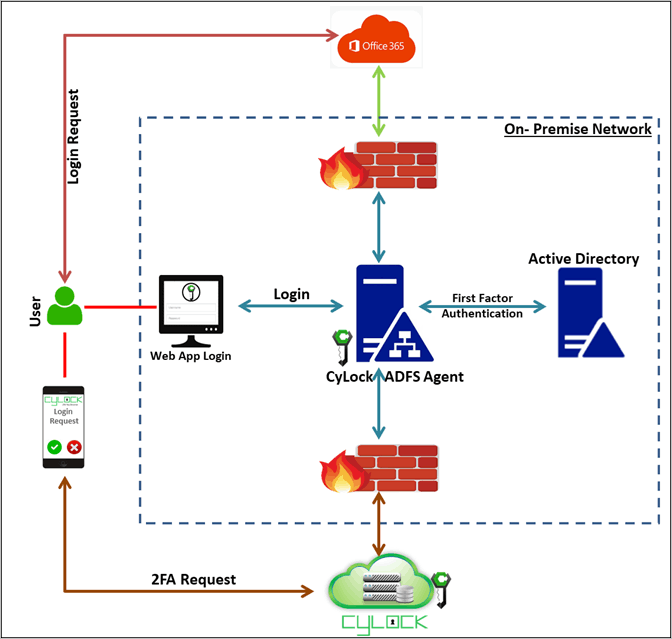Need for MFA
Microsoft 365 (formerly known as Office 365) has emerged as the primary solution for myriad businesses, offering a suite of professional services including email and calendar management, file storage and sharing, team collaboration, and more. As businesses rely heavily on these services, safeguarding their data has become paramount yet poses significant challenges. So, relying solely on a strong password is insufficient to prevent unauthorized access to accounts and sensitive company data.
What can I do?
Implement CyLock MFA an advanced Out-of-Band Multi-Factor Authentication (MFA) solution that can enhance the security during the login process by verifying the identity of the individual signing in before granting access to corporate mail or other resources.
MFA for O365 is enabled through an on-premise Microsoft AD / LDAP Federation Services (ADFS) server which is integrated to the on-premise MS AD / LDAP server, where the authentication of the first-factor happens. O365 will authenticate user against the on-premise AD / LDAP Server.
O365 LOGIN WORKFLOW
Here's how O365 login typically works:
MS AD FS will act as an Identity Provider that enable users to use their existing AD / LDAP accounts to access O365 applications (Web and desktop applications) making the login process more convenient and streamlined.

-
User access outlook application using user’s email address (with its domain name should be same as AD domain name) and password credentials.
-
This credential will be sent to Microsoft O365 email server; if the domain is federated it will redirect the login request to the on-premise AD FS Server.
-
Here AD FS will verify the first factor authentication (FFA) against AD and if the authentication is successful, it triggers second factor authentication with CyLock MFA server.
-
Based on preferred authentication mode user can carry out second factor authenticate and if it is successful, user will be logged into O365 application.
Authentication Options
On top of strong password policies, organizations can enable MFA to provide a more secure Windows logon process. MFA can provide security against cyber-attacks thereby safeguarding enterprise identity and data. The table below lists the authentication types and the security options supported during Windows logon.

Benefits of enabling MFA for O365 Login
Enhanced Security: MFA adds an extra layer of security by requiring users to provide multiple forms of identification before gaining access to their accounts. This reduces the risk of unauthorized access, even if a user's password is compromised.
Protects Against Password Attacks: With the increasing number of sophisticated cyber-attacks like phishing, brute force attacks, and credential stuffing, MFA helps protect against these threats by requiring an additional verification method beyond just a password.
Compliance Requirements:Many industries and regulations require organizations to implement MFA as part of their security protocols to ensure data protection and compliance with regulatory standards such as GDPR, PCI-DSS , HIPAA.
Safeguards Sensitive Data:O365 often contains sensitive and confidential information. The risk of data breaches and unauthorized disclosures is mitigated, as MFA permits access only to authorized users to such information.
CyLock MFA Pre-Requisites for O365
Implementing CyLock Multi-Factor Authentication (MFA) for Office 365 (O365) login involves certain prerequisites to ensure a smooth and secure integration. Here are the typical prerequisites for setting up CyLock MFA for O365:
-
On-Premise AD / LDAP
-
AD / LDAP Domain name and Outlook mail Domain name should be same.
-
AD / LDAP Federation Services (AD FS) feature should be installed in windows server and joined to the domain.
-
Access to CyLock MFA SAAS Server for carrying out Second Factor Authentication
Summary
Multi-Factor Authentication (MFA) for Office 365 is a crucial security feature that helps protect user accounts and data by requiring additional verification steps beyond just a password. It offers enhanced security, flexibility, and ease of implementation, making it an essential component of a comprehensive security strategy for organizations using Office 365.